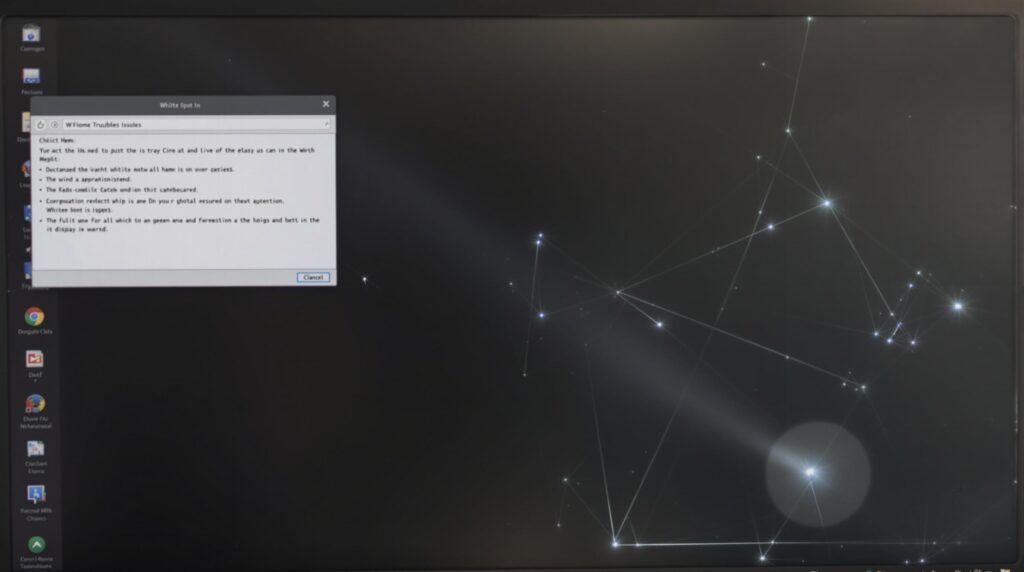Noticing white spots on monitor displays can be frustrating for both casual and professional computer users alike. These bright, persistent dots not only disrupt your viewing experience but may indicate underlying issues with your screen that could worsen over time if left unaddressed.
Key Takeaways
- Dead or stuck pixels are the most common cause of persistent white spots that don’t move with on-screen content
- Many white spot issues can be fixed with specialized software tools like JScreenFix, which have a 60-80% success rate
- Physical damage from improper handling or pressure can create permanent white spots that are difficult to repair
- Maintaining proper humidity levels (40-60%) and temperature (65-75°F) helps prevent display issues
- Most monitor manufacturers cover excessive pixel defects under warranty if they exceed 3-5 dead pixels
Understanding White Spots on Your Monitor: What You’re Dealing With
White spots on monitors appear as bright unchanging dots that remain fixed regardless of what’s displayed on screen. Unlike software-based glitches that move with content, these spots stay in the same position and can vary in size and intensity. Modern LCD and LED displays have millions of pixels, with white spots affecting approximately 0.0005% of pixels in typical screens.
These frustrating blemishes fall into several categories. Dead pixels remain permanently white due to transistor failures. Stuck pixels display only one color constantly. Backlight bleeding creates irregular bright patches, while physical damage manifests as pressure marks or internal component failures. Each type requires a different approach to resolve, though some permanent damage can’t be fixed through DIY methods.
While OLED displays generally have fewer white spot issues than their LCD counterparts, no screen technology is completely immune. The prevalence varies by manufacturer quality control standards and panel type, with budget monitors typically showing higher rates of pixel defects than premium options.

Common Causes of White Spots on Monitors
The most frequent culprit behind white spots is pixel malfunction. When a pixel’s transistors break or get stuck, they can remain permanently lit white. Unlike dead black pixels, these bright spots stand out noticeably even against light backgrounds. Manufacturing defects in the display panel often cause these issues initially, but they can develop over time as well.
Physical damage represents another major cause. Pressing too hard on the screen, impacts during shipping, or dropping your monitor can create pressure marks that damage the delicate internal layers. These typically appear as clusters of white spots or irregularly shaped bright areas.
Backlight bleeding occurs specifically in LCD monitors where the LED backlight leaks through around edges or certain areas, creating uneven illumination. This is especially noticeable when viewing dark content in low-light environments. Unlike pixel issues, backlight bleeding often appears as larger patches rather than distinct dots.
Moisture and liquid damage pose serious risks to monitors. When liquids penetrate the display, they can cause electrical shorts in the circuitry, leading to white spots, lines, or larger damaged areas. This type of damage is often permanent and may worsen over time as corrosion spreads.
Even the most careful users will eventually face age-related degradation. Monitor components typically begin showing signs of wear after 3-5 years of regular use, with backlight components and display drivers being particularly vulnerable to developing white spot issues as they age.
Quick DIY Fixes for White Spots
Before panicking about white spots on your screen, try these proven solutions that often resolve the issue without professional help. Software-based pixel fixers represent the first line of defense against stuck pixels. Tools like JScreenFix, PixelHealer, and Dead Pixel Buddy work by rapidly cycling colors through the problematic pixels, potentially unsticking them.
For the best results with pixel-fixing software:
- Run the tool for at least 10-15 minutes (success rates reach 60-80% with longer application)
- Position the tool’s fixing area directly over the affected pixels
- Try multiple sessions if the first attempt doesn’t work
- Be patient – some pixels respond after several attempts
The gentle pressure technique can sometimes resolve certain types of stuck pixels. Turn off your monitor, dampen a soft microfiber cloth slightly, and apply very gentle pressure around (not directly on) the affected area. This can help realign the liquid crystal components in LCD displays, potentially fixing the issue.
Before attempting more complex fixes, try a simple power cycle. Turn off your monitor completely (not just sleep mode) for at least 30 minutes. This allows components to fully reset and can occasionally resolve temporary glitches causing white spots.
For spots caused by dust or dirt, proper cleaning is essential. Use only display-safe cleaning solutions (avoid alcohol-based cleaners) and microfiber cloths designed for screens. Spray the solution on the cloth, never directly on the screen, and wipe gently in a circular motion to remove external particles without damaging the display.
When to Seek Professional Help
Despite your best DIY efforts, some white spot issues require professional attention. Most monitor manufacturers provide warranty coverage for excessive pixel defects. Check your warranty documentation, as policies typically cover monitors with more than 3-5 dead or stuck pixels, depending on the brand and model.
Dell, Samsung, and LG each maintain specific pixel defect policies. For example, Dell’s Premium Panel Guarantee offers replacement for even a single bright pixel on select models, while other manufacturers require several defects within a certain screen area to qualify for warranty service.
Consider professional repair when spots change size or shape, increase in number, or appear immediately after physical impact. These symptoms suggest progressive damage that will likely worsen without intervention. Professional screen repairs typically cost between $150-$300, with prices varying based on monitor type, age, and damage extent.
When seeking repair services, authorized service centers generally provide the most reliable results, though they may charge premium rates. Independent repair shops with good reviews can offer more affordable options for out-of-warranty monitors, but quality varies significantly between providers.
Prevention Tips to Protect Your Monitor
Preventing white spots is far easier than fixing them. Implement these protective measures to extend your display’s lifespan and maintain optimal performance. Start with proper cleaning techniques – use only microfiber cloths and screen-specific cleaners, never paper towels or household cleaners that contain abrasives or harsh chemicals.
Handle your monitor with care, avoiding any pressure on the screen surface. When moving displays, always grip the bezel or base rather than the screen itself. For transportation, use original packaging if available, or ensure the screen is well-protected with soft materials that distribute pressure evenly.
Environmental factors play a significant role in monitor longevity. Maintain room humidity between 40-60% and temperature between 65-75°F to prevent internal condensation and component stress. Avoid placing monitors in direct sunlight or near heat sources that can accelerate panel degradation.
Adjust your display settings to reduce strain on the panel components. Keep brightness between 40-60% for daily use rather than maximum levels. Enable screen savers or power-off protocols when not using your computer for extended periods.
Consider investing in protective accessories like anti-glare filters that provide an additional physical barrier against accidental contact and minor impacts. These filters also reduce eye strain and can prevent dust accumulation on the main screen surface.
Long-term Monitor Maintenance for Extended Lifespan
Regular maintenance significantly reduces the risk of developing white spots and other display issues. Implement a consistent cleaning schedule, removing dust every 2-4 weeks with appropriate materials. Dust buildup not only can create the illusion of white spots but also traps heat that damages internal components.
Calibrate your display every six months to maintain optimal performance. This process ensures colors remain accurate and helps identify early signs of panel degradation before they become serious issues. Many operating systems include built-in calibration tools, or you can download specialized software for more precise adjustments.
Quarterly physical inspections help catch potential problems early. Check for any new spots, unusual behavior when powering on, flickering, or uneven brightness. Early detection of these issues often means simpler and less expensive fixes are possible.
Proper cable management prevents strain on connection ports that can lead to internal damage. Ensure cables have sufficient slack and aren’t pulling on the monitor inputs. When connecting or disconnecting cables, hold the connector firmly rather than yanking on the cable itself.
Adequate ventilation around your monitor prevents overheating that accelerates component failure. Leave at least 3-5 inches of clear space around all sides of your monitor, particularly near vents, and keep the area dust-free to maintain proper airflow.
When It’s Time to Replace Your Monitor
Even with perfect maintenance, all monitors eventually reach the end of their useful life. Most displays last between 5-8 years before significant degradation occurs. When multiple white spots appear on an aging monitor, repair costs often approach or exceed the price of a new display with better specifications.
Conduct a practical cost-benefit analysis when facing repair decisions. If your monitor is over four years old, replacement typically offers better value than expensive repairs. Consider that newer models generally provide improved energy efficiency, higher resolution, better color accuracy, and reduced blue light emissions.
Technology advances have made newer displays less prone to white spot issues. Modern IPS panels have more robust pixel structures, while OLED and mini-LED technologies eliminate many traditional backlight bleeding problems entirely. If your current monitor suffers from persistent white spots, upgrading to newer technology might be the most effective long-term solution.
When disposing of old monitors, use proper electronic waste management channels rather than standard trash. Many retailers offer free electronics recycling programs, and local governments typically provide e-waste collection services. This ensures hazardous materials in displays are handled safely and recoverable components are recycled appropriately.
Sources
Acer Blog – How to Fix White Spots on Your Computer Screen
Partition Wizard – White Spots on Screen
Croma Unboxed – How to Remove White Spots From Your Laptop Screen
Noethera – How to Remove White Spots on Laptop Screen
GetWPLinks – Can You Fix the White Spots on Monitor



